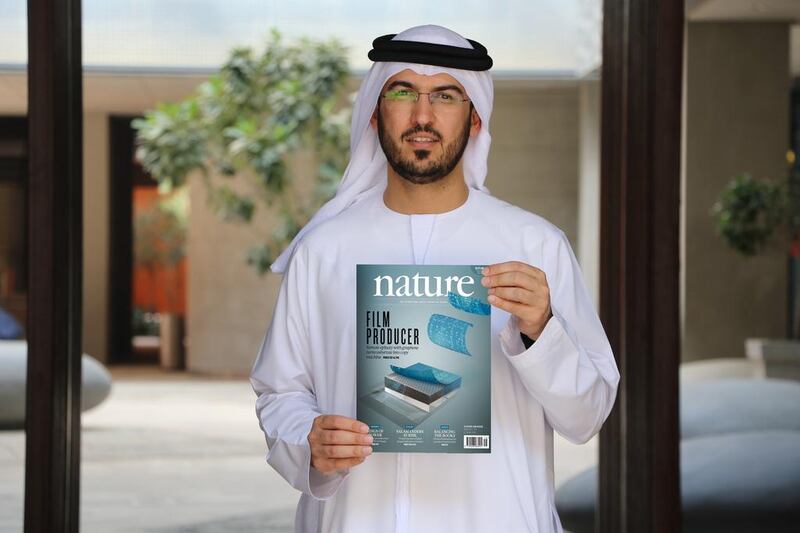While modern life depends on materials that can conduct electricity or insulate, semiconductors are not less vital.
Conducting electricity at a level between that of metals and insulators, they are found in most electronic circuits and play a crucial role in one of the UAE’s key sectors – solar power – as they are a key part of the cells that convert light to electricity.
For most applications, cost is a consideration. For that reason, semiconductors based on silicon, which are cost-effective to produce, predominate.
But there are other materials from which semiconductors can be made.
Research by Emirati Dr Ibraheem Al Mansouri, assistant professor of microsystems engineering at Masdar Institute, could enable these semiconductors to be put to greater use.
Dr Al Mansouri and his fellow researchers have developed a new and cheaper method of fabricating semiconductors made from substances such as gallium arsenide. Such semiconductors are typically more efficient than silicon ones but until now have been much more costly.
Such is the new method's significance that it was recently featured on the front page of Nature, a leading scientific journal.
The work involves producing gallium arsenide semiconductors on an extremely thin film of graphene, a form of carbon, which sits on a base, or substrate, of the same material as the semiconductor, namely gallium arsenide.
This substrate is needed so that the upper layer can form properly. If silicon were used, defects would form.
The upper layer is peeled off while the substrate is left behind, ready for reuse.
As well as gallium arsenide, other types of III - V semiconductors – so named because one element comes from Group III of the periodic table and the other from Group V – can be produced by using the technique.
Examples include gallium phosphide and indium phosphide.
Such semiconductors can cost more than 100 times as much as silicon semiconductors, so they have often been found only in satellites and other niche applications where cost is less critical.
With the new method, the uses to which they could be put are much wider, including wearable technology.
In co-authoring a paper published in Nature, Dr Al Mansouri, 31, has achieved a significant feat for a young scientist.
An Abu Dhabi native, he completed his undergraduate studies in electrical engineering at the American University of Sharjah in 2008.
In Germany, he pursued a master’s degree and conducted research at the Fraunhofer Institute for Solar Energy Systems and the University of Freiburg.
For his doctorate, he researched photovoltaics, including silicon cells, at the University of New South Wales in Australia, completing it in 2015.
Dr Al Mansouri later went to the United States and capitalised on the close links between the Masdar Institute and the Massachusetts Institute of Technology, where he worked with Dr Jeehwan Kim, an assistant professor who holds patents for photovoltaic technologies.
Much of the research for their paper was centred on Dr Kim’s research group.
Both men are now looking at how they might commercialise their technique.
The paper that describes their work, Remote Epitaxy through Graphene Enables Two-Dimensional Material-Based Layer Transfer (epitaxy means growing a crystalline material on a substrate), was written by 17 researchers.
Other researchers are also interested in new types of semiconductors. Among them is Martin Kuball, professor of physics at the University of Bristol.
His research centres on semiconductors such as gallium nitride, which offer improved efficiency and lower weight.
Some of these novel semiconductors are prone to overheating, and Prof Kuball looks at how this can be prevented.
“If you drive down the cost significantly, it would help non-silicon technology,” he says.
Dr Al Mansouri says there are many applications for the semiconductors that he is working on, including wearable technology, where smart devices are connected to the internet.
There could also be implications for the solar power industry, especially as the III – V semiconductors could be used in multijunction solar cells, which have more than one type of semiconductor on top of each other.
Different types of semiconductors are able to make use of different wavelengths of light, so using more than one type can boost electricity generation by harnessing a greater range of wavelengths.
“We can transfer [the gallium arsenide] on top of the silicon. This opens up possibilities. One of the advantages is that we can compete on cost,” says Dr Al Mansouri.
He expects his technique to have a niche application in the solar industry, a sector that is expected to supply a quarter of the UAE’s energy needs by 2050.
The semiconductor technique could also be used in the space industry, an area in which the UAE has a growing interest.
So thanks to Dr Al Mansouri and his colleagues, many areas of technology could be poised for a big step forward.
newsdesk@thenational.ae







